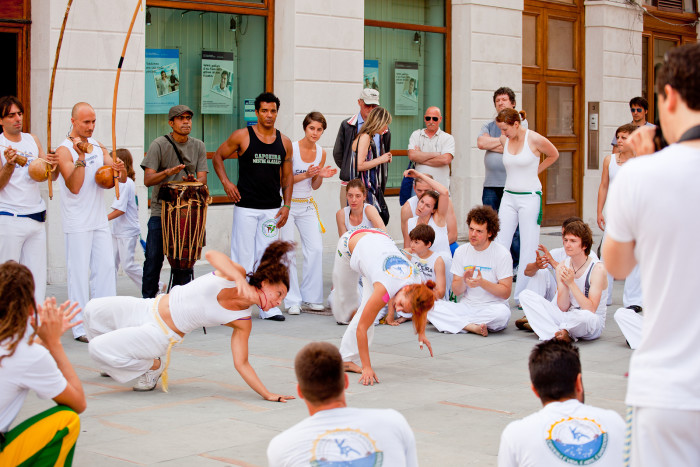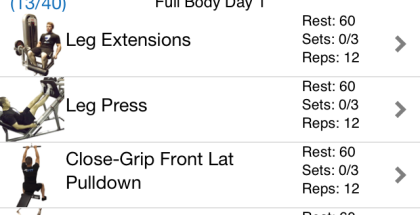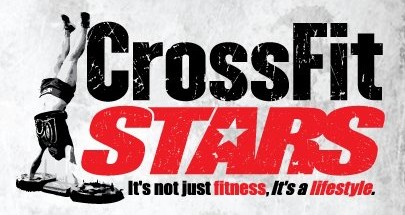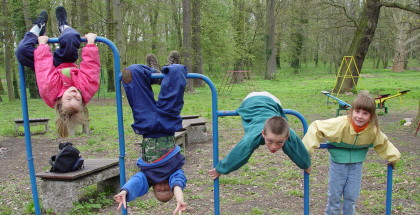Capoeira, a dancing fight
May 16, 2013 | Hadeel El DeebThe first time I heard about Capoeira was through my friend Rahim Hamada in 2011 and I remember the endless questions I asked him about it; “huh? What is that?” “Oh so it’s some sort of martial arts thingy?” “So it’s like a dance?” “I don’t understand, you stand in a circle and watch each other do those weird moves?” I also remember how interesting it all sounded when he tried to explain to me and yet how intimidating it seemed to someone like me who barely does any kind of sport.
Then one day, a big group of us was in Sinai and a sudden excitement rushed over when we heard that the Capoeira group would be passing by the camp to say hello. That’s when my mind got hooked on the idea, after meeting them and seeing it all first-hand. They all formed a circle, which I later learned to be called Roda and couple with what looked like handmade instruments started playing ethnic music. Then two at a time went in the middle of the circle and started engaging in a sort of performed fight. The stamina, fitness and resilience I encountered were the most striking, especially when I saw how the girls went about it. Their energy was contagious; the few of us who were standing around watching were at awe.
Capoeira is a beautiful form of workout that combines music and a form of dance with non-violent self-defense moves. It is an excellent form of exercise that helps improve one’s endurance, agility, flexibility, balance and rhythm. With regards to weight loss, research says that an hour of Capoeira helps you burn around 500 calories. Practicing Capoeira is also of great benefit to one’s concentration and perseverance and also has a definite impact on fearlessness.
Hamada kept suggesting that I should join; I would really enjoy it, he said. One thing stopped me, and that was the fear that I would look silly when I can’t do what they do. I was certainly intimidated and thought I was too clumsy and lacked basic coordination to perform something so beautifully complicated.
I finally stepped up and gave it a shot. I didn’t take part in the actual class (yet) but I dragged Hamada to have an intro talk and asked him to teach us some basic moves to share with you.
Two things to note before you watch:
1. Ignore my little belly; I had had almost half a kilo of watermelon before we started, so be kind.
2. Suski’s (Nadine El Sayed’s dog) head always make an appearance in our shoots.
The Ginga (pronounced Jinga)
Ginga’s literal definition is to rock back and forth. It is the fundamental move of Capoeira and the one where every other move stems from. This move is very rhythmic and it’s what prepares the capoeirista’s body for all the other moves; it keeps the person always in motion and hence a more difficult target to actually attack.
Rolê (rolling motion)
This is considered the basic method to move around in the Roda; the key is to always stay low and closer to the ground while always keeping track of the player in front of you. Hamada kept reminding me to always keep eye contact while my head is between my arms as you can see in the video below.
Esquiva
The literal meaning is to escape or dodge another move. It’s mainly about moving your body and head out of the attacker’s way. Esquiva has more than one form; the one Hamada taught me below is where you would mainly escape a kick.
PS: We asked him to perform a little Capoeira routine to conclude the video for you to have a more inviting reaction than that of my horribly performed moves.
Hamada then took me to the actual class so we’d see the workout routine and how it leads to the Roda concluding the class.
Off we went to Egypt’s Fencing Club downtown where, again, I was struck by the group’s energetic vibe.
They started with about 30 minutes of quite an intense warm up routine including pushup rounds, jogging, jogging backwards, jogging sideways, walking on all fours but in a bridge-like form with your back facing the ground, jumping jacks and many more. The warm up continued with some of Capoeira’s basic techniques that the video below shows.
The last 30 to 45 minutes of the class are dedicated to the exciting Roda. Heading that Roda – Capoeira’s center circle – is the ‘bateria,’ which is the row of instruments that leads the participants and sets the rhythm of the players. The participants forming the circle clap along with the ‘berimbau,’ the leading instrument, and percussions, while someone leads the vocals with a solo ‘ladainha’ and the others echo the chorus. The music usually starts slow and then transcends and goes quicker making the performed fight faster and more exciting.
Origins and Evolution of Capoeira
Capoeira is believed to be connected to tribal fighting that took place in Angola, where a lot of the tribes would engage in fights to acquire a desired woman. The traditional way of doing it was to fight body to body without the use of any weapons while the contestants were always pushed in a circle.
During the colonial period, the martial art started growing as a means of survival by the African slaves brought to Brazil from Angola, Mozambique and Congo. They would hide their traditions and mask them into a form of dance as a way to fight oppression and also lift their spirits. After slavery was banned, they started forming gangs due of unemployment, which led to Capoeira being associated with crime and later on against the law in Brazil up until 1892.
In 1937, the very first school of Capoeira “Academia-escola de Capoeira Regional” was established at the Engenho de Brotas in Salvador-Bahia by Manuel dos Reis Machado, known as Mestre Bimba. He was the reason Capoeira was recognized as an official national sport after he performed it in front of president Getúlio Varga.
If you decide to give it a go, which I certainly recommend you do, this is what you need to know to join:
Location: Fencing Club, Downtown
Days: Sundays, Mondays, Tuesdays and Thursdays
Time: 8:00 pm to 10:00 pm
Price: EGP 50 for drop-in, EGP 250 per month
Instructor: Passoka Da Bahia Angelo
For any questions, contact Rahim Hamada on: 01222430046

























